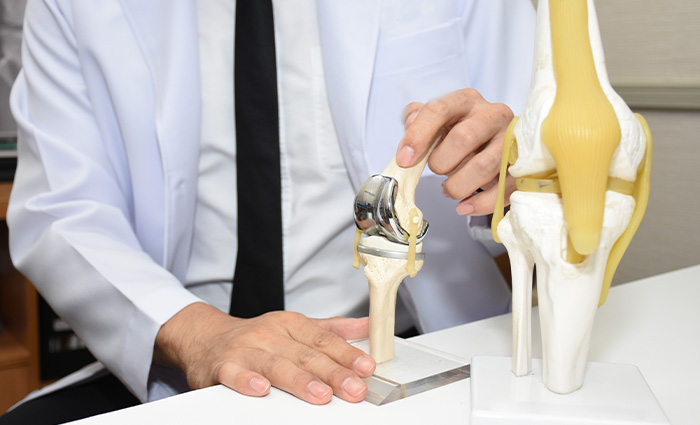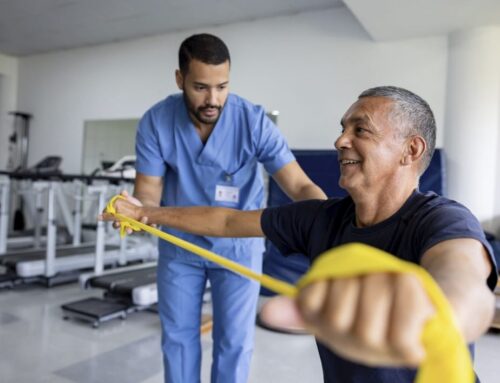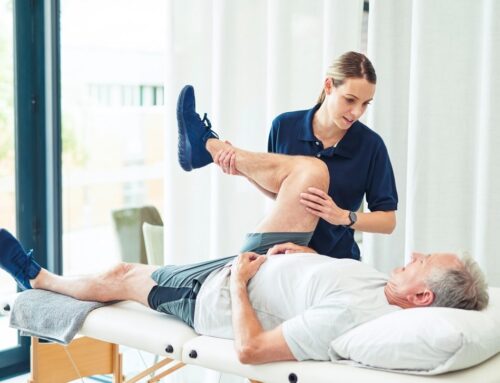While joint replacement surgeries have become commonplace in today’s orthopaedic spectrum of care, the idea of having a painful joint removed and replaced with a synthetic joint can seem frightening. This article talks about the joint replacement recovery process to help patients feel more relaxed and prepared.
History and prevalence of joint replacement surgery
Joint replacement surgery, or joint arthroplasty, removes damaged or diseased sections of joints and replaces them with new, artificial parts. Hips, knees, shoulders, elbows, ankles and fingers are candidates for replacement. Following the joint replacement recovery period, patients report greatly reduced pain and easier movement.
Early joint replacement surgery dates back more than 100 years, and continues to grow in popularity year after year. According to the American Joint Replacement Registry, nearly 1.9 million people in the U.S. received artificial joints in 2019, with numbers projected to increase to 4 million annually by 2030.
Over the past decade, total knee and total hip replacements have accounted for 53% and 33% of all joint arthroplasty surgeries, respectively. Women are more likely to have these procedures than men.
Immediately following joint replacement surgery
You just had joint replacement surgery. Everything went smoothly, and now the medical staff has wheeled you off to the recovery room. From there, the anesthesia will slowly leave your system. You will have minimal pain, but pain medications curb most of the discomfort.
Your orthopaedic doctor will want you to start moving around soon – either with a walker or crutches – to prevent blood clots. You may also get compression sleeves for your legs and blood thinner medication to reduce the risk of clotting.
With a knee arthroscopy, you will likely use a continuous passive machine (CPM) to start your joint replacement recovery. This device passively and repeatedly moves the knee through a specified range of motion, helping to prevent scar tissue buildup and relieve joint stiffness.
Depending on the joint you had replaced, your pain level and range of motion, you may be able to go home on the same day as the surgery. However, patients usually stay in the hospital for one to three days, with nurses and physical therapists assisting with exercises and movement.
On discharge day, you will have a family member or friend drive you home and get you adjusted. Many doctors suggest having meals already prepared, so you do not have to worry about standing and cooking. Have everything you need placed at waist level. Once you are home, follow all the instructions from your orthopaedic doctor and medical staff.
Physical therapy
After surgery, you will see a physical therapist to start the rehabilitation process. Your physical therapist will lead you through various exercises to increase the mobility of the new joint and strength in the muscles surrounding it. You will be given exercises to do at home, and each day you will work to strengthen the joint.
Physical therapy after a joint replacement is extremely important to ensure the best possible outcome, and patients often continue PT appointments for weeks or months after the surgery.
The do’s and don’ts
After a joint replacement, you can resume many of your normal activities. Doctors recommend avoiding high-impact exercises like running or skiing and suggest low-impact workouts like walking, water aerobics and hiking. You will continue visiting your physical therapist and doctor until they give you the all-clear.
While you are healing, do not bend or lean down to pick up items. Instead, use an assisted device. Do not lie on the affected area, and avoid pivoting your leg. Lie with a pillow between your legs, use your crutches or walker, wear supportive clothing, sit on firm chairs or couches and keep your legs straight with your toes pointed towards the ceiling.
By following the orthopaedist’s orders, most patient have a full recovery within six months. If you have any questions or concerns at any time during your joint replacement recovery, please contact your physician immediately.
Long-term outcomes
Life after a joint arthroplasty has a bright outlook, which is why these procedures are gaining in popularity.
With a new hip, doctors expect you to feel significantly better than before surgery. Studies show that 90% of hip replacement patients feel better and return to their normal activities a few months (or a few weeks in some cases) after surgery.
Patients with knee replacements start moving the joint right after surgery, so the knee will heal quickly. The joint will feel significantly better, and you will have more mobility and strength. Most individuals can return to their normal activities within six weeks, and a synthetic knee can last up to 15 years!
Find out if joint replacement surgery is right for you
If wear and tear has left you with chronic knee, hip or shoulder pain and you are wondering if a joint replacement is right for you, see one of our joint replacement specialists for a consultation. Cary Orthopaedics has board-certified specialists on our team who have performed countless joint replacements and can advise you for the best outcome.






